Importance Of Quality Management Assignment
Question
Task: Write a report on quality management assignment, critically discussing the importance of tools and several aspects of quality management.
Answer
Operational Development
1.Definition Of Quality In Terms Of Value
According to the research on quality management assignment, quality plays a huge role and is a clear indication of a brands ability to deliver high valued products that last longer to its customers (Sethi 2000).
"Quality is all about meeting the needs and expectations of customers."
Customers want quality that is appropriate to the price that they are ready to pay and the level of competition in the market.
Key Aspects of quality for the customer include:
- Good Design-looks and style
- good functionality does the job well
- Reliable-acceptable level of breakdowns or failure
- consistency
- Durable-lasts as long as it should
- good after-sales service
- value for money
The study developed within this quality management assignment signifies that “Value for money' is especially mandatory, because in most markets there is room for products of different overall levels of quality, and the customer must be satisfied that the price fairly reflects the quality (Williamson 2010).
For example, Easy jet and George at Asda Clothing ranges, even though it may be 'low quality in terms of style or features, these products still give good value for money for their overall level of quality.
So, it can be stated herein quality management assignment that the quality is important since it will allow the consumer to benefit more by accessing higher quality which would result in bringing down the overall cost of the products or services over its lifespan (Steen 2007).
2. Importance of Quality Management
It’s important for every product to deliver a combination of both high quality and affordability to the consumer, thus striking equilibrium (Excellence 2001). It also increases the value of the product since it delivers on two or more dimensions, making it a preferred choice among consumers. It is a modern competitive market as it delivers more value for money on products and services. Some important benefits linked to quality management are outlined below within this quality management assignment:
- High quality helps build customer confidence.
- Results in customers returning to purchase the product and services
- Improves the brand's reputation
- Builds brand popularity
- Improves the brand's new product acceptance to markets
The above points mentioned in the quality management assignment illustrates that it’s important to understand the quality affects product and service delivery and is a major factor linked to a brands reputation thus must always be upheld. With an increasing number of customers, competition in the industry is growing intense brands, and if they do not work on quality then they can expect failure. Quality is the main factor examined in the context of quality management assignment that linked to any product or services success and failing to adhere to high levels of quality will only lead to damaging the company's reputation leading to loss of consumer faith. Consumers require to be provided with high quality at all times, and this requires being part of the company's ethics so as to gain and retain consumer trust. Customers do not always have to test the quality of a product to know its quality and the manufacturer must actually take this responsibility to constantly check on product quality and maintain the highest quality at all times. Quality control also requires to be broken down into different departments each falling at a different stage of the manufacturing process but should start from the initial stage or seeking raw materials and be performed randomly through production to the final stage which is sales (Montgomery 2009).
3. Explain TQM of Quality Management in regards to the case scenario of quality management assignment
Total Quality management refers to the careful balancing of the verity of aspects linked to quality; these are ranging from the raw materials, price, availability, safety and consumer demand (Isaksson 2006). It’s very important to deliver on each of the product quality management aspects so as to cater to each of the consumer’s requirements and deliver products which are highly demanded in the market by the consumer. Total quality control is associated with managing all aspects linked to a process and being able to monitor as well as improve quality throughout the entire manufacturing process. To deliver the best TQM, the company must take into consideration the factors discussed in the following section of a quality management assignment.
- Customers will define the quality requirements for products and services.
- Top management is responsible for quality improvement.
- Constant research and improvements must be made on products and services.
- Quality assurance is a team effort requiring each individual to maintain quality
- Comparisons to competitor product and services must be constantly made.
The study developed within this quality management assignment also illustrates that TQM also requires for each of the individuals on an assembly line or process to be able to monitor and measure the quality of products despite the station they are posted. It helps increase the quality of products being manufactured since it allows more people to monitor the process, product or service and this automatically results in increasing product quality. Quality is not limited to the product but also take other aspects into consideration as well as the consumers perspective linked to the product or service. Failing to recognise and implement each of the aspects will only lead to complication due to failing to recognise one and promoting others. Another major benefit stated herein quality management assignment linked to this is having a larger number of eyes monitoring the process which results in reducing the likelihood of the product quality dropping since there are more people observing and monitoring the process (KANNAN 2005).
4. The Role Of The Tool In Every Process
It’s important to understand how to identify the tool linked to every process since this helps the individual gain a direct understanding linked to what is being discussed. The tools linked to every process will usually involve the product or service in question or the one which requires to be modified to make improvements (Tarí & Sabater 2004). The tool linked to every business or process varies greatly, and many processes will have more than one, thus requiring the tool to be mentioned clearly allowing the investigator to identify it and act on it. Some examples of tools have been discussed below in the quality management assignment to make understanding the tools easier.
a. Can you justify the explanations of the tools identified in the context of quality management assignment?
Being a woodworking company, the team would need to identify the nature and cause of the items in the scrape and recycle bin and what has caused the damage to the items. It would result in identifying the tools causing the damage to the woodwork, which can be used by the team to identify solutions to the damage occurring to furniture in the future (Montgomery 2009). Water, mound, termites, weak or softwood, rote and several other wood damaging tools can be identified (Nugier et al. 2007). In addition to this, it is also clear in this segment of quality management assignment that the wood species must also be identified to determine the best quality wood to use on furniture to reduce the amount of damage occurring to the wood. Being able to identify the tool or item in question is the main factor linked to the successful research and development of a product or process, and these require to be closely understood.
b. Assessing Paper Quality And Moisture Absorption
The concept of paper quality considered in the present scenario of quality management assignment greatly depends on the rate of moisture absorption from the air, which also helps determines the papers ink blotting point. It makes it important for the pulp from different tree species to be measured to determine those that absorb the least amount of moisture (Callet et al. 2012). For paper registering a high rate of moisture absorbance alternative approached like wax sealing can be used to prevent the moisture reaching the paper surface. It is the responsibility of the paper manufacturer who is supposed to evaluate the paper to determine the quality and modification required. Paper quality is not limited to appearance and must take other aspects into consideration, including.
- The papers ink absorbability – writing paper must absorb just enough ink to prevent blotting.
- Paper also requires retaining the ink without dissipating into the paper.
- The size of the different paper required on a daily basis, including at schools as well as office stationery.
- Recyclability – delivery of the higher quality recyclable paper
- Materials used to make the paper.
Each of the above factors depicted in this quality management assignment must be taken into close consideration since the paper is a common daily use commodity which is used and can be recycled to reduce the pressures on the environment. The paper manufacturer must also consider environmental and social implications linked to processing paper. These are important to address as they help demonstrate the company’s contribution towards reducing its negative environmental impact and also how it is addressing social concerns. In this situation, the tools linked to the paper manufacturing will take a wide verity of shapes, but each must be closely monitored to ensure it delivers the very best to the consumer. It is because the consumer is the main tool in every business, and their needs must be addressed first as they are the individual who will consume the product or service.
c. Identifying The Causes And Intensity Of Iron Contamination
Iron is highly corrosive when exposed to certain elements and to identify the tools causing iron contamination it’s important that samples of the iron are exposed to different corrosion accelerators which would help determine the rate of correction and effects on the iron ore quality (Icard-Vernière et al. 2013). The experiment considered in this segment illustrates that the causes of the corrosion would be identified as the tools linked to the iron quality degradation after which measurements were taken on different materials to determine the intensity of damage caused by each.
d. Collection Of Complaint Data From Business Branches
Food remains as the most popular consumer item and delivering the highest quality is a key element linked to keeping consumers happy. The study build in this quality management assignment depicts that it’s important to constantly collect information as a tool for improving quality, size and popularity thus it’s critical to use certain tools to collect the information (Fornell & Wernerfelt 1988). The Complains and suggestion boxes are an important source for information and customers from each branch should be requested to fill anonymous questionnaire, suggestions and complain forms to identify areas that require improvement.
e. Hospital Transfer Delay Timing
As discussed in this segment of quality management assignment, to identify patient transfer delay timing, it's important for hospital staff to collect information from transfer form requests and arrival timings after which the ambulance drivers need to point out the reasons linked to the delay which would be identified as the tools causing the delay. Solutions would require being determined by identifying alternative routes for traffic-jammed roads, thus speeding up patient transfers (Chalfin et al. 2007). The causes of transfer delays would be the tools in this situation and solutions to each problem can be researched on to determine approaches which will reduce medical transfer delays.
f. Plywood Production Step Identification
Plywood quality is closely linked to the technique used to prepare or make the plywood thus making it important for the analysis teams to pay close attention to how the veneer grain is laid. The veneer grain layout would, therefore be the main aspect linked to determining plywood quality and be identified as the tool for quality assessment (Hoong & Paridah 2013). The research on quality management assignment also requires checking different veneer grains layout and tests made to determine the difference and effects on quality. It would help determine the most suitable, cost-effective and strongest plywood manufacturing technique. The tool in this situation would be the veneer layout as it would be the tool which requires to be closely monitored to determine the strongest layout thus allowing the manufacturer to use the most effective approaches towards manufacturing the plywood.
1.Statistical Process Control Techniques

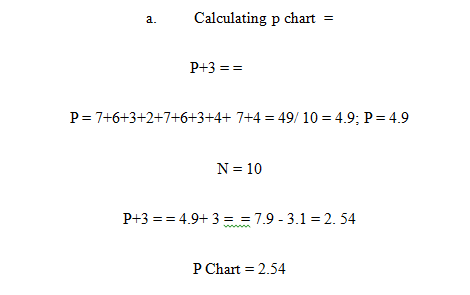
b.UCL & LCL Definition
The lower and upper control units are the average ranges within which the p Chart moves. The ECL and LCL help identify the mean upper and lower average for p chart (Liserre et al. 2005).
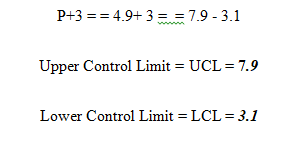
c. Control Chart = Average, Grand Mean, UCL & LCL
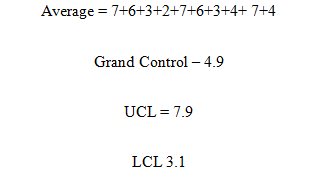
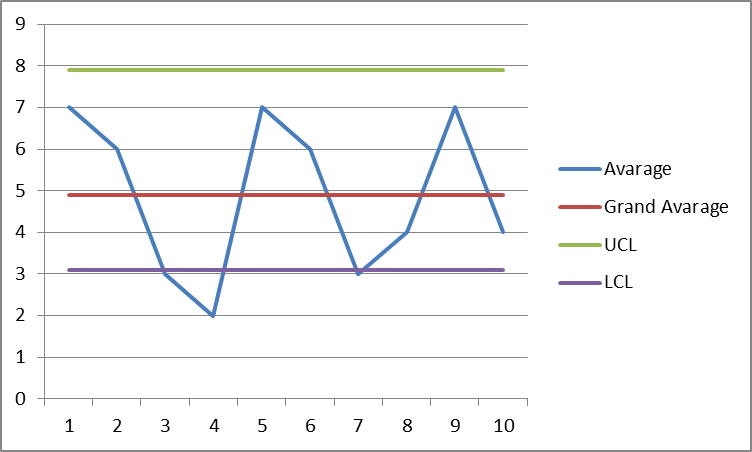
d. Identification Of The Process Control
After the calculation of the statistics linked to the process control provided in the quality management assignment, it is clear that the process control is not uniform or predictable due to the daily statistics fluctuating greatly. For a process control to be controllable, the differences should be small and manageable where the differences are small and do not range widely (Bersimis et al. 2007). On the above chart provided in this quality management assignment, it’s clear the average falls from 7 to 2 in 2 days before rising again and falling in the same sequence. But it’s also clear in this quality management assignment that there is a pattern linked to the average movement but rebounding at a higher lower control level each time (Engell 2007).
1.Home Brand Company
a. x = 170.1 r = 23.3
b. UCL = 14.175 LCL = 1.94
c.
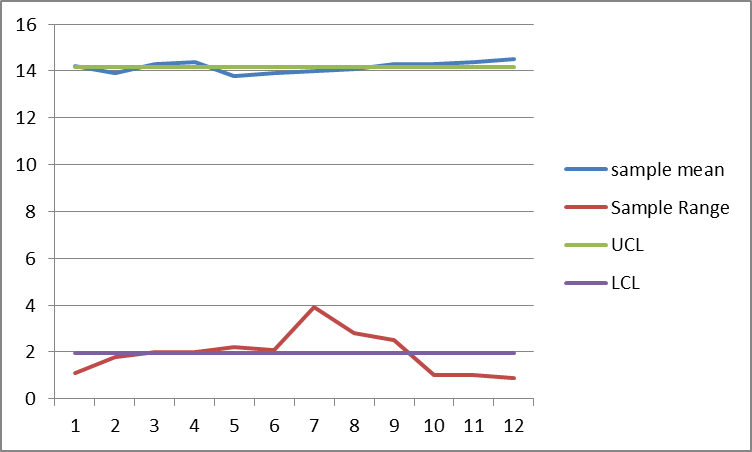
d. By observing the above operations process, it is clear that the process is in control whereby the UCL, LCL and Sample range remain within close proximity. It allows for the prediction of movement trends which helps improve future prediction and movement.
- Using External Benchmarking To Determine And Improve Product Quality
To determine and measure product quality, the content developed in this quality management assignment depicts that it’s important for businesses to use available benchmarking process which would allow measuring their own performance and qualifying statistics (Pipino et al. 2002). These can then be used to compare the performance of the business to competitors in the industry, both locally as well as in the international market. These benchmark statistics will help identify quality statistic ranges which can be used to improve product quality and price to deliver better products or services to the consumer (Vinayak & Kodali 2013).
- Determine Suitable Business Suburbs To Set Up A New Business
While selecting a new business branch location, it's important to take into consideration a wide range of factors and not only customer availability (Bonner & Walker 2004). To help identify the best location, the business must identify location falling under the average income level as well as those with the most customers and low rentals and overhead costs. According to the two superb statistics considered herein quality management assignment, Suburb 2 is the preferred location to set up the business due to the location having higher infrastructure rating and more suppliers. Households are slightly lower than superb, but over time this can be expected to rise. Labour can also be imported to the area from neighbouring regions, thus resolving the labour shortfall experienced in location Suburb 2 (Nurmi & Koolwaaij 2006).
- Facility Location
It's important to also carefully evaluate the variable cost linked to the product price and quantity over turnover so as to determine the most suitable locations to set up a business. The variable cost requires falling under an average, not too low or too high while still retaining an acceptable fixed cost.
|
Location A |
Location B |
Location C |
|
|
Fixed Cost |
60,000 |
120,000 |
220,000 |
|
Variable Cost |
1.5 |
0.90 |
0.5 |
|
Selling Price |
1.2 |
1.20 |
1.2 |
- By analysing the above table provided in the quality management assignment, it's clear that location A attracts the least fixed cost yet attracts the highest variable cost which means the product cost would rise if adequate sales are not made. Location C attracts a very low Variable cost but also attracts the highest fixed cost making it the most expensive location to set up the business. The most suitable location is Location B which attracts an average variable cost and well as fixed costs. It allows the business to balance investment costs and reduce losses incurred during periods the business may not sell the higher burger sale expectations.
- An accurate sales prediction is important in the present context of quality management assignment when using this technique since it helps determine an accurate variable rate the business can expect.
- With larger burger consumer market the location choice would differ due to the increased turnover rate which would reduce the Variable cost further and help generate more income which would make the fixed cost worthwhile due to the business converting more sales through a large number of burger sales.
1.The Role Of Layout Design
The concept of layout design analysed in this segment of quality management assignment plays an important role in mapping out a business's space, thus allowing the business to utilise the maximum amount of space available. For restaurants like McDonald's, this is important since fitting the maximum number of customers into each shop results in an increased sale and reducing overall costs (Sharif & Maletic 2010). The investigation carried on this quality management assignment depicts that while planning the layout it’s also important to deliver comfort to avoid congesting the customers while they consume their meals thus requiring the layout to deliver a specific square foot are per seated of standing customer to deliver the best comfort layout to each customer.
2. Developing Healthier Menus And Consumer Habits
While fast foods have been identified and accused of promoting obesity, it’s important to develop a plan which addresses both McDonald’s contributions to developing healthier menus as well as the customer's responsibility towards following a healthy lifestyle. It would not be fair to eliminate the current menus since many consumers still prefer these foods and take the necessary precaution to prevent health problems associated with the food (Glanz et al. 2007). A healthier menu must be introduced in each McDonald restaurant to cater to customers who consider the traditional menus as unhealthy. In addition to introducing a new menu, it's also important to emphasise, encourage and demonstrate the importance of practising a healthy life that burns the extra calories and keeps McDonald customer healthy despite consuming fast food (Fitzmaurice et al. 2003). The findings obtained in this section of quality management assignment mentions that it's also important to take into consideration the taste aspect of food which is a major contributor to McDonald's food popularity which many customers are not willing to sacrifice. Product quality is not the only issue concerned with obesity since consumers also need to begin performing physical excises to burn the extra calories they consume in McDonald's meals.
3. Motivating McDonald Employees
Being a food and beverage production company, McDonald's finds itself in a venerable position where the company is heavily reliant on the employees to uphold product quality. It makes it important to implement suitable motivational practices for their employees; this would keep them happy and always ready to deliver the highest quality services. It is most effectively achieved by involving the employees and work teams towards the motivation exercise practice which would see employees selecting venture they have an interest in and those which will help motivate employees (Diefendorff & Chandler 2011).
The readings developed in the quality management assignment states that personal interest is growing in popularity and a motivational approach since each individual has their own interest and more likely to perform better when offered the opportunity to participate in their practice which interests them. Personal interest promotion will vary depending on the individual’s interest but involving these as motivational drivers will ensure employee retain their interest towards their job. It also allows the employee to realise the company is genuinely interested in helping them promote their personal interests and skills. It allows company employee to build trust with their employer, thus remaining longer on the job and being keener towards the employee's development growth and delivery of high quality (Markos & Sridevi 2010).
Role of Organization in Business Success
As stated herein quality management assignment, organisation is the key elements linked to any businesses success, and it's critical to make sure business leaders implement the latest organisation skills to ensure work is performed in an organised manner (Shane & Delmar 2004). Failing to develop effective organisational approaches will only lead to major complication linked to employee performance where there would be a lack of communication which would gradually lead to productivity problems and losses. It makes it vital to develop an organised manner of leading a business since this would improve efficiency as well as deliver comfort to the consumer as well as the workforce.
As per the present quality management assignment, Companies that fail to implement effective organisation strategies result in being plagued by chaotic incidents where managers and employees are constantly clashing without each having a definite direction linked to the development of company’s growth.
References
Bersimis, S., Psarakis, K. & Panaretos, P., 2007. Multivariate statistical process control charts, an overview. Quality and Reliability Engineering International, 13(5), pp. 517–543.
Bonner, J.K. & Walker, O.M., 2004. Selecting influential business to business customers in new product development: Relational embeddedness and knowledge heterogeneity considerations. Quality management assignment In Journal of Product Innovation Management. pp. 155–169.
Callet, P. Le, Möller, S. & Perkis, A., 2012. Qualinet white paper and definitions of quality of experience (2012). European Network on Quality of Experience in ….
Chalfin, D.B. et al., 2007. Impact of delayed transfer of critically ill patients from the emergency department to the intensive care unit. Critical care medicine, 37(6), pp.1477–1483.
Diefendorff, J.M. & Chandler, M.M., 2011. Motivating employees. In APA handbook of industrial and organisational psychology, Vol 3: Maintaining, expanding, and contracting the organisation. pp. 65–135.
Engell, S., 2007. Feedback control for optimal process operation. Journal of Process Control, 17(3), pp.203–219.
Excellence, Q., 2001. Total Quality Management ( TQM ). Total Quality Management, 12(4), pp. 1–5.
Fitzmaurice, G. et al., 2003. Tracking menus. Proceedings of the 20th ACM symposium on User interface software and technology UIST 03, 5(2), pp. 71–79.
Fornell, C. & Wernerfelt, B., 1988. A Model for Customer Complaint Management. Marketing Science, 7(3), pp.287–298.
Glanz, K. et al., 2007. How Major Restaurant Chains Plan Their Menus. The Role of Profit, Demand, and Health. Quality management assignment American Journal of Preventive Medicine, 32(5), pp.383–388.
Hoong, Y.B. & Paridah, M.T., 2013. Development a new method for pilot scale production of high grade oil palm plywood: Effect of hot-pressing time. Materials and Design, 45, pp.142–147.
Icard-Vernière, C. et al., 2013. Iron contamination during in-field milling of millet and sorghum. In Journal of Agricultural and Food Chemistry. pp. 10377–10383.
Isaksson , Raine , 2006. Total quality management for sustainable development: Process based system models. Business Process Management Journal, 12(5), pp. 632–645.
KANNAN, V., 2005. Just on time total quality management, and supply chain management: understanding their linkages and impact on business performance. Omega, 37(2), pp.153–162.
Liserre, M., Blaabjerg, F. & Hansen, S., 2005. Design and control of an LCL-filter-based three-phase active rectifier. IEEE Transactions on Industry Applications, 41(5), pp.1281–1291.
Markos, S. & Sridevi, S., 2010. Employee Engagement?: The Key to Improving Performance. International Journal of Business and Management, 6, pp.89–96.
Montgomery, D., 2009. Introduction to statistical quality control,
Nugier, S., Goasdoue, V. & Laboisse, B., 2007. a Comparison Framework for Data Quality Tools. Main, p.15.
Nurmi, P. & Koolwaaij, J., 2006. Identifying meaningful locations. Quality management assignment In 2006 3rd Annual International Conference on Mobile and Ubiquitous Systems: Networking and Services, MobiQuitous.
Pipino, L.L., Lee, K.W. & Wang, R.C., 2002. Data quality assessment and Communications of the ACM, 45(4), p. 211.
Sethi, R., 2000. New Product Quality and Product Development Teams. Journal of Marketing, 64(2), pp. 1–14.
Shane, S. & Delmar, F., 2004. Planning for the market: Business planning before marketing and the continuation of organising efforts. Journal of Business Venturing, 19(6), pp.767–785.
Sharif, B. & Maletic, J.I., 2010. The effects of layout on detecting the role of design patterns. In Software Engineering Education Conference, Proceedings. pp. 41–48.
Steen, O., 2007. Practical knowledge and the importance for software product quality. Information and Software Technology, 49(6), pp.625–636.
Tarí, J.J. & Sabater, V., 2004. Quality tools and techniques, are necessary for quality management. International Journal of Production Economics, 92(3), pp.267–280.
Vinayak, K. & Kodali, R., 2013. Benchmarking the quality function deployment models. Benchmarking, 20(6), pp.825–854.
Williamson, P.J., 2010. Cost innovation: Preparing for a “value-for-money” revolution. Quality management assignment Long Range Planning, 43(2-3), pp.343–353.












